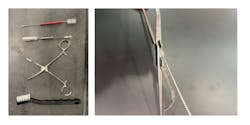Hemostats, box locks, and fractures: oh why?!
Q
We are having issues with a lot of our hemostats being fractured in the box lock area. Can you share your thoughts on why this might be happening?
A
To me, one of the most common causes of fractured box locks is poor cleaning. My first response is: do you know how many brushes are needed to clean these simple instruments?
If you answered at least two brushes, you are correct! We all know you need to brush the external surface. Usually, a soft bristle brush or even a wipe (depending on what the instructions for use [IFU] states) can be used.
What is the second type of brush you need, and where do you use it?
While these medical devices (hemostats) seem simple, you must pay particular attention to the hinges, crevices, ratchets, serrations, and other hard to clean areas to make sure you remove all organic debris. If you do not brush properly, debris (e.g., dried blood) may be left behind. If the debris is not removed, it can get baked on during the sterilization process and may cause the box lock to crack. Thus, prevention of the buildup of “baked on” debris and mineral deposits is important to avoid box lock fracture/damage.
I was able to find some quotes backing up my thought process. “Found in box locks (joints) and other tight spaces, crevice corrosion often appears as red rust. It is caused by blood and other soils that gather in box locks that haven't been properly cleaned. … Improper cleaning can lead to the stiffening of an instrument's joint. Soil buildup typically occurs in the box lock (joint) - the weakest part of the instrument. When the box lock cannot hold any more debris, a stress crack occurs in the joint; the crack is noted at the pin joining male and female parts of the instrument. Once this crack occurs, the instrument can't be repaired. It must be immediately removed from the instrument set because it can fail at any time. Also, the blood and body fluids that enter the crack will not be completely removed, no matter how vigorous the cleaning efforts.”[i]
(Based on my observations), the box lock area is sometimes forgotten to be cleaned. If it remains dirty, [over time] it can cause box lock fractures and the medical devices are damaged permanently (beyond repair). I usually see just brushing the external surface and not much detail—deep cleaning/brushing—is given to the box lock area.
It should be noted that fracturing of the box lock area can also be caused “from over-clamping or sterilizing with ratchets closed.”[ii]
My brush of choice is a trumpet style brush. You could use other brushes that fit the area of the box lock, but I have found this trumpet brush fits nicely into most medical devices that have box locks, like hemostats. You can combine it with a nice box style brush for the other parts of the external surface and the serrations. Now you have a winning combination to reduce fractured box locks!
Also, work with your repair company. What I mean is, if you have fractured box lock(s), save some to show your staff. The repair person could even do an in-service for your staff on the issue of why the box lock fractured. Pictures help tell a great story.
Remember, you need friction and fluid to clean any medical device properly. Be sure to keep the medical device completely under the waterline when brushing according to the manufacturer’s IFU. Proper brush selection and brushing will help any medical device reprocessing departments make their medical devices last longer and remain clean and functional. Like I always say, “Keep it Clean.”References
1. Chobin, Nancy. (2007, October 10). Pitfalls to Avoid in Instrument Reprocessing. Outpatient Surgery-A division of AORN, August 2007–Infection Prevention. https://www.aorn.org/outpatient-surgery/article/2007-August-pitfalls-to-avoid-in-instrument-reprocessing.
2. Schultz, R. (2019). Hemostats 101: Understanding One of the Most Common Surgical Instruments. RMPS Publishing. https://www.rickschultz.org/pub/media/wysiwyg/Nov.-Dec-2019-Instrument-Whisperer-Final.pdf.
About the Author

Stephen M. Kovach
Stephen M Kovach, BS, CFER, started in the medical field in 1975 as a sterilization orderly and has worked in many positions within the Healthcare Industry. He presently is Clinical Educator Emeritus at Healthmark, A Getinge company.

